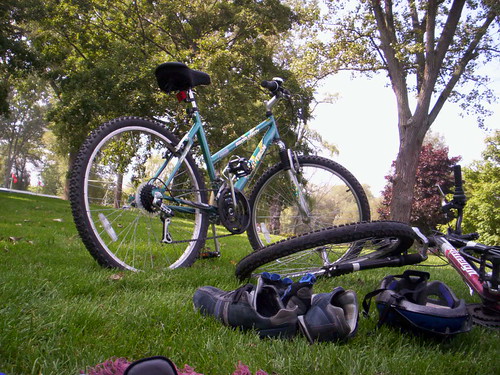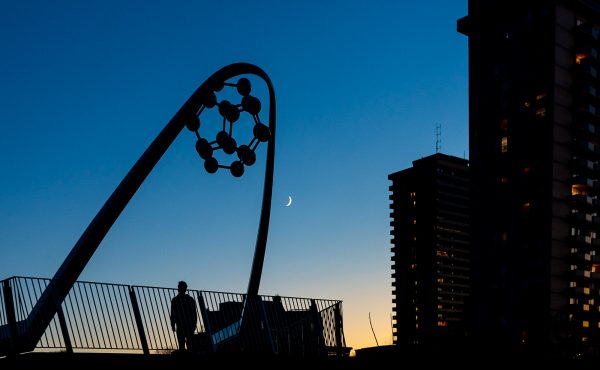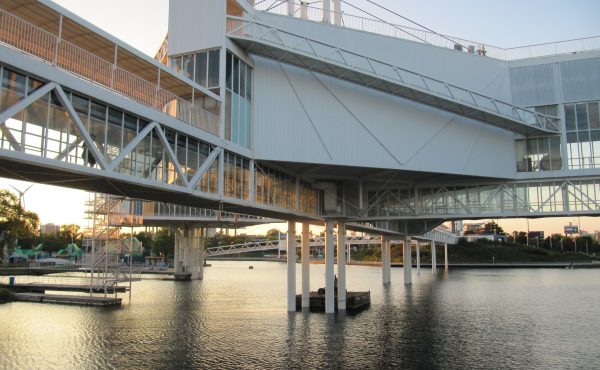
One of the key strategies for a greener and cleaner Toronto proposed in the City’s new clean air plan, Change is in the Air, is to complete the Bikeway network by 2012 and begin implementing a pedestrian plan.
The focus on improving bike and pedestrian infrastructure in Toronto has been mainly on the streets — expanding bike lanes, adding and beautifying sidewalks. But there is a whole other part of these networks: trails, pathways, and bridges in Toronto’s extensive park/ravine system. By contrast to streets, this side of the bike and pedestrian network has been largely neglected, and in fact has decayed in recent years.
An example of this neglect can be found in this year’s capital budget for Toronto’s Parks, Forestry and Recreation Division. This capital budget is split between funds for new projects and funds for keeping the existing infrastructure in decent shape — “State of Good Repair” (SGR). The estimated accumulated backlog of SGR needs for ensuring that park paths, trails and bridges remain in good repair is just over $20 million dollars — a quarter of the entire “state of good repair” requirements for parks — and yet the amount budgeted in 2007 for accomplishing this required maintenance was less than a million dollars ($800,000). By contrast, indoor arenas require about $12 million and were given $4.5 million in 2007 — over a third of their need.
The big winner, though, was park parking lots, which need just over $2 million in state of good repair work and were assigned $1 million in 2007 — half of what they need, the highest proportion of any item in the Parks SGR budget. You heard that right — the biggest priority for maintenance in Toronto’s green spaces is the asphalt parking lots. Cars in parks get more “state of good repair” money than the entire network of trails for cyclists and walkers, despite the fact that these trails need ten times as much money just to stay in decent shape.
(I am grateful to Martin Koob of Bike Toronto for these numbers. They are buried in the detailed line-by-line analyst’s notes for the Parks budget, which are not available online and were only available in print at the barely-publicized capital budget open house).
Meanwhile, the Bikeway Network Expansion budget line item for building new Bikeway Network Projects in parks has been reduced to $400,000 for 2007, down from the already modest 2006 level of $500,000. According to an analysis by Martin Koob of Bike Toronto, that’s enough to build a whole 2 km of new trails. At the current rate, there is no chance that the parks portion of the Bikeway strategy will be completed for decades to come.
One of the key problems is that there is no one person in Parks, Forestry and Recreation who is responsible for paths and trails, can analyze their situation, and champion them in discussions of budgets and priorities.
That is why the Toronto Cycling Committee, supported by the Toronto Pedestrian Committee, has called for the creation of a Senior Trails and Pathways Planner position — a Trailmaster — within the Parks Division. They would have specific responsibility for maintaining and planning the expansion of pathways in Toronto’s parks. They would also provide a link with the Transportation Division to help ensure that pathways were well-connected to sidewalks and bike paths so they become part of a coherent network for cyclists and pedestrians. This position might also prevent problems such as the recent controversy about the West Toronto Railpath, by anticipating the need for separate paths for cyclists and pedestrians before the design process begins.
The city’s 2007 operating budget does not provide funds for this position, unfortunately, but it’s possible it could be created by re-organizing within the existing Parks, Forestry and Recreation Division.
With someone taking on this role, the missing parts of the Toronto Bike plan and the city’s pedestrian network — pathways, trails and bridges — would get the attention they need if the City of Toronto’s environmental goals are to be met.
photo by Joe at Biking Toronto on Flickr




11 comments
I was attempting to ride just this afternoon down Black Creek as part of a project I am working on. I was very fustrated that while there’s public land across both sides on the boxed-in waterway, there’s no continous trail, forcing me to go up the grades into residential and industrial areas and make long detours – the fact that I was forced to do this had me see some fairly interesting things, but I wouldn’t want to do it again anytime soon.
I used to live in Brampton, and found almost the opposite: nice long ravine trails along even the most inconsequential steam, often grade-separated and relatively well-maintained (many even plowed in the winter). I even commuted to my job one summer largely using the Etobicoke Creek trail.
As for Black Creek: stay tuned.
Someone needs to light a fire under ??? about the Don River trail. It has been closed south of King since last summer while a better path is made under the rail bridge. (A very good idea!) It was supposed to reopen in May but the latest news I have seen is “July” and I bet it’s delayed further. This is a critical link in the bike path system and I can’t see why it can’t be opened (at least on weekends) much sooner.
Then there’s the Unwin Street bridge on the Martin Goodman trail just west of Leslie (near Tommy Thompson Park.). This was closed to cars last fall as it is clearly on its last legs. Admittedly there is a VERY narrow cycle/pedestrian path still open but even today, when it was not prime cycling weather, this was a bottle-neck. In summer it will be very difficult.
There is no sign of any work being done at the Unwin Bridge so I guess it will not be fixed or replaced (it’s a Baillie Bridge) for months. The bridge may not be able to support car or truck traffic but why not reopen the main span for cyclists / pedestrians ONLY?
The Cherry Street bridge (at Lakeshore) is also closed at present (since last fall) but it is being worked on. It is scheduled to reopen in late April and it looks like they may make that deadline.
The idea of trying to light a fire under ??? is a wonderful characterization of the current state of all this.
I fully support this idea, granted that the planner is able to bring in more than the $300,000+ the city is likely to pay for their salary/support staff/offices.
I don’t know how likely that’ll be.
Salaries for intelligent, motivated, competent civil servants are worth way more than the salary we pay them. We pay so many bullshit care-for-nothing people comfortable $$, anytime we get a person that really does care, and really has a sense of duty, is worth everything and more.
Some mixed feelings about this post because:
-we aren’t doing very much on the streets for bikes
-focussing on doing paths in the parks means the city can point to how much they do for cyclists while running them off of the public road (and this may be an issue for women too in that they may feel unsafe in a different way on park paths at night/even day), or letting the cars take over the centre turn lanes
– and the TWRC and the Conservation Authority are both helping the City actually do some extra things for cyclists, or even doing big things themselves thanks
Thanks for thanking Martin Koob for being a source of detailed info – he’s done huge amounts of not-fun work for cyclists with Heather.
And there’s money around – is it $50 or $100M set aside for the Front St. Extension, and the Gardiner car drivers don’t pay a cent for their limited access “free”way, and regrettably within the bike sphere, is the Railpath project such a great deal at $2.6M? Will it save any lives? (The City deserved a suit with Galen’s death as it didn’t provide a curb cut in fresher concrete at that intersection since we don’t want to have cyclists riding on a sidewalk and as there wasn’t any sidewalk on the other side why put one in?)
May I suggest lighting fires under politicians for effective and fair transport spending?
Can someone tell Hamish that every comment he makes doesn’t have to bring up the Front St. Extension. Not every discussion on bikes has to relate to it.
Yes, thanks I know. But it’s a quarter-billion buck gift to out of town cars, screws up two transit systems, and it’s car-based thinking that keeps cars driving through/into downtown, and if we EVER want to have a car-reduced city, (better for bikes, peds, the air and the urban core) I think we gotta really kill this off, and many of the “progressives” support it.
Sorry, but for me it’s the dominant issue for future of the city/public space. Compare $125,000,000 a km for FSE vs. $25,000 to paint a street for bike lanes.
It’d be nice if someone else were to pick up on it though it sure helps to have Adam Vaughan actively fighting it now.
Gardiner motorists do pay the province (PST/fuel tax) but not Toronto – another downloading triumph.
I like the strategies for a greener and cleaner Toronto proposed in the City’s new clean air plan. If most of the people cooperated, many people will benefit especially the future generations.
I do really support this proposal providing that it will help out everyone for making the air clean and fresh to breathe. Well who would want to breathe smoke from cigarettes and vehicles? Definitely none. This plan also conserve petrol and lessen the number of smoke belchers which is good for our health.